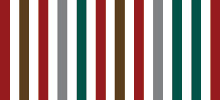=
By Chandra van Binnendijk
[An abbreviated version of an essay first published in The Wakaman Project catalogue, 2009]
10 Years' Independence, monumental painting design, by Ray Daal (1985)
The name Waka Tjopu is derived from an old-fashioned Surinamese marbles game, where the aim is reach a new and more distant target with each turn. The players try to touch -- to “tjop” -- and gather as many of their opponents’ marbles as possible. The name perfectly suits the activities of the artists’ collective set up in the 1980s, whose members were continuously stimulated by touching on the specialities of others in the multidisciplinary collective.
Visual artist and designer René Tosari founded Waka Tjopu in 1983. He played a leading and decisive role in its development until the end of the collective. Other members of the collective were the artists Soeki Irodikromo, Ray Daal, Steve Ammersingh, Winston van der Bok, John Djojo, and Ramin Wirjomingolo.
Designers, illustrators, graphic designers, painters, decorators, ceramists, photographers, artists, sculptors, batik artists, and wood and metal craftsmen were all represented in the collective. What brought them together was their conviction about the practice of art: that art and society are inextricably linked to each other. The climate in Suriname in the 1980s challenged them to make their own interpretation of values; a promise of progressive social renewal initially offered by the military coup.
Waka Tjopu wanted its work to make a purposeful contribution to increasing the cultural identity and self-respect of Surinamese people. For its members, artistic manifestations had not only an authentic, expressive, and aesthetic value; they also thought that the foundation for developing works of art lay within the immediate social reality. This was the vision from which they worked.
One Waka Tjopu project clearly expressed their deep and heartfelt connection with the environment. From 1983 to 1984 the artists regularly visited the district of Commewijne, where a number of them had their roots. The area had a rich plantation culture history, but few who remembered it. Among the run-down and dilapidated remains the Waka Tjopu artists found renewed inspiration for what would be their most remarkable enterprise, which they lovingly christened Terug Naar Huis (“Back Home”).
As they wandered through the abandoned plantations they talked passionately about “art confrontations”, a term they often used to describe the creation of interactivity between social reality and artistic expression. They had close contact with the plantation inhabitants and shared their day-to-day activities, recording the entire district in paintings, sketches, and photographs; a triptych portraying the present, the past, and the future of the plantations on the right bank of the River Commewijne. The paintings, linked to an actual restoration project for the area, have a historical, a current, and a future portrayal of the area in the style of historical pieces. The Terug Naar Huis works represented Suriname’s participation in the prestigious 18th Biennale of Sao Paolo (1985), and were exhibited again in 1990, in Theater Thalia in Paramaribo. They are now housed in the Openlucht Museum in Nieuw Amsterdam, in Commewijne -- they are back home.
Terug Naar Huis project, design for triptych (1985)
During its seven years of existence, Waka Tjopu was engaged in a huge range of exciting activities including architectural works and designs, banners, and a television flash card series themed on original craft forms such as native ceramics, traditional basketwork, and wood carving. Art was also used to illustrate subjects such as standards and values, healthy eating and economic progress through production. These projects encompassed making district signs, designing complete house-styles for new companies, industrial design, making scale models, drawing postcards, caricatures and comic strips, and holding art workshops at schools in the city and in the districts.
Waka Tjopu also felt very strongly about public service issues, such as good parenting and the value of local qualities. It was the collective that made the first, colourful giant signs in Suriname drawing attention to the importance of local production and good education for all. In addition Waka Tjopu also took on the design for the national industries rapidly emerging at this time, and was responsible for the design and furnishing of some major, high-profile production fairs showing locally produced goods. A spectacular example was the design, dressing, and performance for two historic processions with floats through Paramaribo in 1985, held to celebrate five years of revolution and ten years of independence. Waka Tjopu was entrusted in 1988 with designing a national AIDs campaign and all the associated informational material.
By now the collective’s work had expanded to include a city face-lift, applied art, and architecture. Members of the group were involved in designing and making objects and the decoration of interiors and building facades. For many years the facade of De Surinaamsche Bank was adorned with a number of greatly enlarged Surinamese coins including the old-fashioned two-and-a-half cent piece or “bigi sensi”, and the curious, square five-cent piece.
The collective was actually disbanded in 1990, and the members continued with their creative work as individuals in their own discipline.
Waka Tjopu occupies a unique position in the history of the visual arts in Suriname. This type of group experience for artists had never taken place before, and has never been repeated since. Their collaboration radiated a great deal of strength and inspiration. Not only did the Waka Tjopu members produce an enormous amount, but they also modernised due to their purposeful approach, focussed on social consciousness-raising. And they undeniably inspired subsequent generations of artists.
Left, poster design for the foundation of the 25 February Movement, by René Tosari (1984). Right, poster design for World Environment Day, by Winston van der Bok (1985)
All images from the Waka Tjopu archive
Reading: on Waka Tjopu
Tuesday, July 28, 2009
at 8:31 PM
Labels: reading, tosari, van binnendijk, waka tjopu, wakaman
Subscribe to:
Post Comments (Atom)






0 comments:
Post a Comment